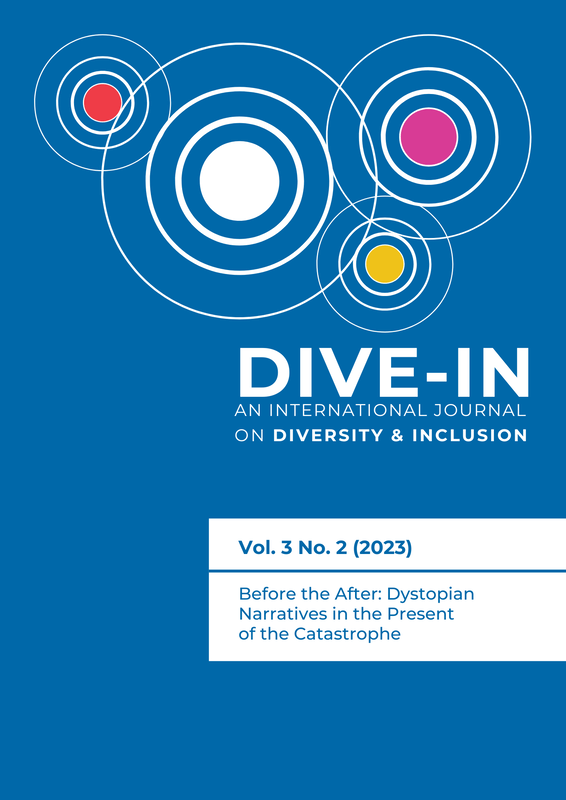Spersonalizzazione del personaggio e inclusione del lettore: da Noi di Evgenij Zamjatin (1921) a Notre vie dans les forêts (2017) di Marie Darrieussecq
DOI:
https://doi.org/10.6092/issn.2785-3233/19134Keywords:
Anthropocene, depersonalization, dystopia, inclusion, posthumanAbstract
This paper analyzes two dystopias belonging to different worlds and eras: one from the 20th century, We, by Russian writer E. Zamjatin and the other from the 21st century, Notre vie dans les forêts, by the French M. Darrieussecq. This literary journey of a century allows us to focus on themes dear to the dystopian genre but especially related to the lives of today’s readers, in the spirit of engaged literature. In particular, readers will be prompted to reflect, with the help of some critical insights, primarily on the disasters of the Anthropocene and on the depersonalization experienced by humans in a world that changes too quickly and in which the boundaries between human and nonhuman seem to have been obliterated. Starting from this last element, the article considers a new model of inclusion of the different, the posthuman, through the studies of Rosi Braidotti and Donna Haraway.
References
“Marie Darrieussecq présente une dystopie haletante, Notre vie dans les forêts”. 15/09/2017, https://www.youtube.com/watch?v=N-SGdGRDZQE [ultimo accesso 16/06/2023].
Arpaia, Bruno. 2018. Distopia, realismo aumentato, presente estremo. 17 ottobre 2018, https://ilbolive.unipd.it/it/news/distopia-realismo-aumentato-presente-estremo, [ultimo accesso 17/06/2023].
Barabanov, Evgenij. 1988. Kommentarij (Commento). In Tamara Gromova & Marietta Čudakova (eds.), E. Zamjatin Sočinenija (Opere). Moskva: Kniga.
Booker, Keith. 2013. Critical Insights: Dystopia. Ipswich, Massachusetts: Salem Press.
Bouvier, Quentin Patrice. 2022. Au-delà des lettres: Pour une redéfinition écologique systémique dans une france contemporaine. Chapel Hill: University of North Carolina. (doctoral dissertation).
Braidotti, Rosi. 2013. The Posthuman. Cambridge: Polity Press.
Buell, Lawrence, 2009 (2005). The Future of Environmental Criticism: Environmental Crisis and Literary Imagination. Hoboken: Blackwell.
Carlini, Dominique. 2020. “Poétique de la science chez Marie Darrieussecq.” Dalhousie French Studies 115, 3–10.
Chaudet, Chloé. 2016. Écritures de l’engagement par temps de mondialisation. Paris: Classiques Garnier.
Darrieussecq, Marie. 2017. Notre vie dans les forêts. Paris: P.O.L.
Deotto, Fabio. 2018. “Il tempo del realismo aumentato.” Il Tascabile, 16 aprile 2018, https://www.iltascabile.com/letterature/tempo-realismo-aumentato/ [ultimo accesso 09/06/2023].
Di Minico, Elisabetta. 2018. Il futuro in bilico. Il mondo contemporaneo tra controllo, utopia e distopia. Roma: Meltemi.
Fréville, Carine. 2020. “Révolte contre l’effacement et sur-vie à l’ère de l’hypertechnologie dans Notre vie dans les forêts de Marie Darrieussecq”. Dalhousie French Studies 115, 89-105.
Guattari, Félix. 1989. Les Trois écologies. Paris: Galilée.
Haraway, Donna. 2016. “Anthropocène, capitalocène, plantationocène, chthulucène. Faire des parents”. Multitudes 65, 75-81, https://www.cairn.info/revue-multitudes-2016-4-page-75.htm [ultimo accesso 16/06/2023].
Haraway, Donna. 2018. Making Kin not Population: Reconceiving Generations. Chicago: Prickly Paradigm Press.
Heller, Leonid. 1990. “Evgenij Zamjatin”. In E. Etkind, G. Nivat, I. Serman, V. Strada (eds.), Storia della letteratura russa. III. Il Novecento, 2. La Rivoluzione e gli anni Venti, 515–532. Torino: Einaudi.
Holmes, Martha & Becky Miller. 2001. “Entretien avec Marie Darrieussecq at University of Arizona”, 12 dicembre 2001, https://mariedarrieussecq.com/entretiens [ultimo accesso 12/06/2023].
Kim, Annabel. 2020. “A tale of two forests: Marie Darrieussecq’s humanism.” L’Esprit Créateur 60, 73–84.
Lamoureux, Frédérique. 2020. “Dans l’urgence d’écrire la trace : pour une lecture énonciative et discursive de Notre vie dans les forêts de Marie Darrieussecq.” Postures – Revue, critique littéraire 31, 1–12.
Laugier, Sandra. 2012. Tous vulnérables? Le care, les animaux et l’environnement. Paris: Payot & Rivages.
Malabou, Catherine. 2017. Métamorphoses de l’intelligence: que faire de leur cerveau bleu? Paris: PUF.
Malvestio, Marco. 2022. “Theorizing Eco-Dystopia: Science Fiction, the Anthropocene, and the Limits of Catastrophic Imagery.” European Journal of Creative Practices in Cities and Landscapes 1, 24–38.
Moore, Jason W. 2015. Capitalism in the Web of Life: Ecology and the Accumulation of Capital. London: Verso Books.
Muzzioli, Francesco. 2021 (2006). Scritture della catastrofe. Istruzioni e ragguagli per un viaggio nelle distopie. Milano: Mimesis edizioni.
Niero, Alessandro. 2018. “Noi, ritratto futuribile.” In Evgenij Zamjatin, Noi, v-xviii. Milano: Mondadori.
Oliver, Annie (ed.). 2007. Écrire l’histoire d’une vie. Santa Maria Capua Vetere: Spartaco.
Posthumus Stéphanie. 2014. “Écocritique et ecocriticism. Repenser le personnage écologique.” Figura 36, 15–33.
Sargent, Lyman Tower. 2013. “Do Dystopias Matter?” In Fatima Vieira (ed.), Dystopia(n) Matters. On the Page, on Screen, on Stage, 10–12. Cambridge: Cambridge Scholars Publishing.
Serres, Michel. 2020. Le Contrat naturel. Paris: Flammarion.
Trout, Colette. 2016. Marie Darrieussecq: Ou voir le monde à neuf. Leiden: Brill.
Vinge, Vernor. 2008. “Signs of the singularity.” IEE Spectrum 45, 76–82.
Zamjatin, Evgenij. 1970. Tecnica della prosa. Bari: De Donato.
Zamjatin, Evgvenij. 2018. Noi. Milano: Mondadori.
Downloads
Published
How to Cite
Issue
Section
License
Copyright (c) 2023 Sofia Tincani

This work is licensed under a Creative Commons Attribution 4.0 International License.





